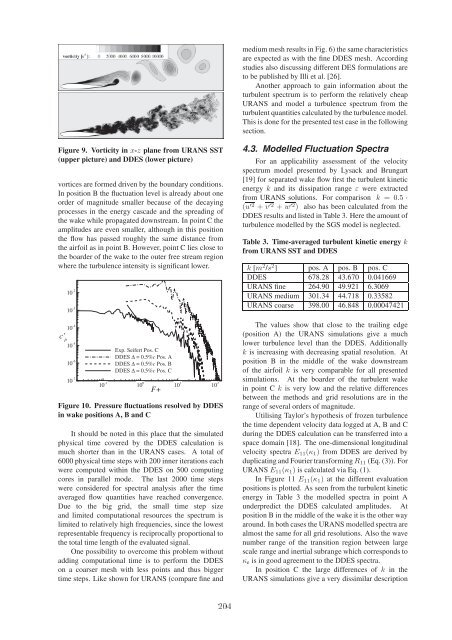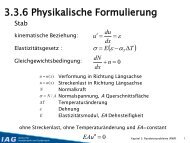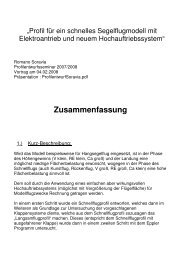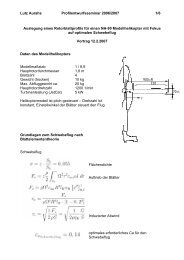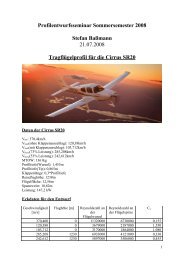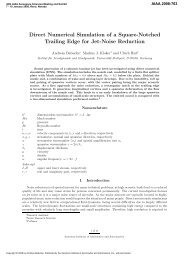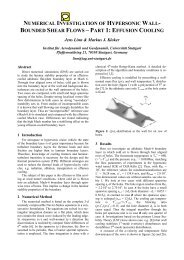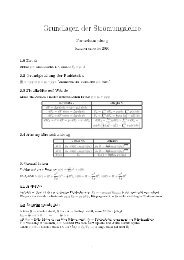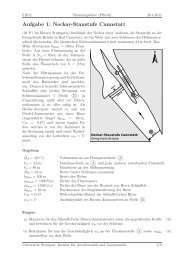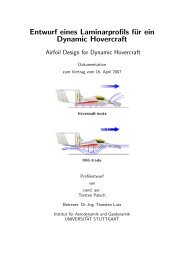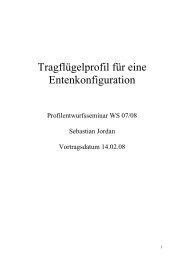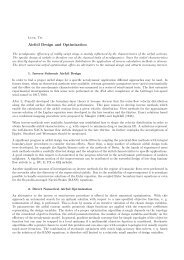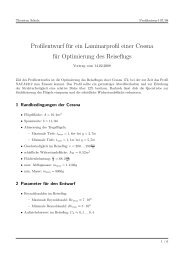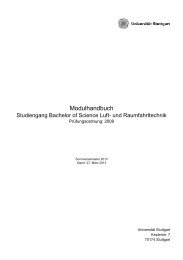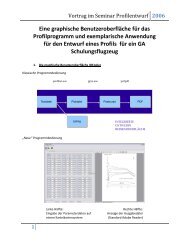NUMERICAL SIMULATION OF LOW-SPEED STALL AND ... - IAG
NUMERICAL SIMULATION OF LOW-SPEED STALL AND ... - IAG
NUMERICAL SIMULATION OF LOW-SPEED STALL AND ... - IAG
You also want an ePaper? Increase the reach of your titles
YUMPU automatically turns print PDFs into web optimized ePapers that Google loves.
medium mesh results in Fig. 6) the same characteristics<br />
are expected as with the fine DDES mesh. According<br />
studies also discussing different DES formulations are<br />
to be published by Illi et al. [26].<br />
Another approach to gain information about the<br />
turbulent spectrum is to perform the relatively cheap<br />
URANS and model a turbulence spectrum from the<br />
turbulent quantities calculated by the turbulence model.<br />
This is done for the presented test case in the following<br />
section.<br />
Figure 9. Vorticity in x-z plane from URANS SST<br />
(upper picture) and DDES (lower picture)<br />
vortices are formed driven by the boundary conditions.<br />
In position B the fluctuation level is already about one<br />
order of magnitude smaller because of the decaying<br />
processes in the energy cascade and the spreading of<br />
the wake while propagated downstream. In point C the<br />
amplitudes are even smaller, although in this position<br />
the flow has passed roughly the same distance from<br />
the airfoil as in point B. However, point C lies close to<br />
the boarder of the wake to the outer free stream region<br />
where the turbulence intensity is significant lower.<br />
10 -3<br />
4.3. Modelled Fluctuation Spectra<br />
For an applicability assessment of the velocity<br />
spectrum model presented by Lysack and Brungart<br />
[19] for separated wake flow first the turbulent kinetic<br />
energy k and its dissipation range ε were extracted<br />
from URANS solutions. For comparison k = 0.5 ·<br />
(u ′2 + v ′2 + w ′2 ) also has been calculated from the<br />
DDES results and listed in Table 3. Here the amount of<br />
turbulence modelled by the SGS model is neglected.<br />
Table 3. Time-averaged turbulent kinetic energy k<br />
from URANS SST and DDES<br />
k [m 2 /s 2 ] pos. A pos. B pos. C<br />
DDES 678.28 43.670 0.041669<br />
URANS fine 264.90 49.921 6.3069<br />
URANS medium 301.34 44.718 0.33582<br />
URANS coarse 398.00 46.848 0.00047421<br />
10 -2 Exp. Seifert Pos. C<br />
c’ p<br />
10 -4<br />
10 -5<br />
10 -6<br />
10 -7<br />
DDES ∆ = 0.5%c Pos. A<br />
DDES ∆ = 0.5%c Pos. B<br />
DDES ∆ = 0.5%c Pos. C<br />
10 -1 10 0 10<br />
F+<br />
1 10 2<br />
Figure 10. Pressure fluctuations resolved by DDES<br />
in wake positions A, B and C<br />
It should be noted in this place that the simulated<br />
physical time covered by the DDES calculation is<br />
much shorter than in the URANS cases. A total of<br />
6000 physical time steps with 200 inner iterations each<br />
were computed within the DDES on 500 computing<br />
cores in parallel mode. The last 2000 time steps<br />
were considered for spectral analysis after the time<br />
averaged flow quantities have reached convergence.<br />
Due to the big grid, the small time step size<br />
and limited computational resources the spectrum is<br />
limited to relatively high frequencies, since the lowest<br />
representable frequency is reciprocally proportional to<br />
the total time length of the evaluated signal.<br />
One possibility to overcome this problem without<br />
adding computational time is to perform the DDES<br />
on a coarser mesh with less points and thus bigger<br />
time steps. Like shown for URANS (compare fine and<br />
The values show that close to the trailing edge<br />
(position A) the URANS simulations give a much<br />
lower turbulence level than the DDES. Additionally<br />
k is increasing with decreasing spatial resolution. At<br />
position B in the middle of the wake downstream<br />
of the airfoil k is very comparable for all presented<br />
simulations. At the boarder of the turbulent wake<br />
in point C k is very low and the relative differences<br />
between the methods and grid resolutions are in the<br />
range of several orders of magnitude.<br />
Utilising Taylor’s hypothesis of frozen turbulence<br />
the time dependent velocity data logged at A, B and C<br />
during the DDES calculation can be transferred into a<br />
space domain [18]. The one-dimensional longitudinal<br />
velocity spectra E 11 (κ 1 ) from DDES are derived by<br />
duplicating and Fourier transformingR 11 (Eq. (3)). For<br />
URANS E 11 (κ 1 ) is calculated via Eq. (1).<br />
In Figure 11 E 11 (κ 1 ) at the different evaluation<br />
positions is plotted. As seen from the turbulent kinetic<br />
energy in Table 3 the modelled spectra in point A<br />
underpredict the DDES calculated amplitudes. At<br />
position B in the middle of the wake it is the other way<br />
around. In both cases the URANS modelled spectra are<br />
almost the same for all grid resolutions. Also the wave<br />
number range of the transition region between large<br />
scale range and inertial subrange which corresponds to<br />
κ e is in good agreement to the DDES spectra.<br />
In position C the large differences of k in the<br />
URANS simulations give a very dissimilar description<br />
204


